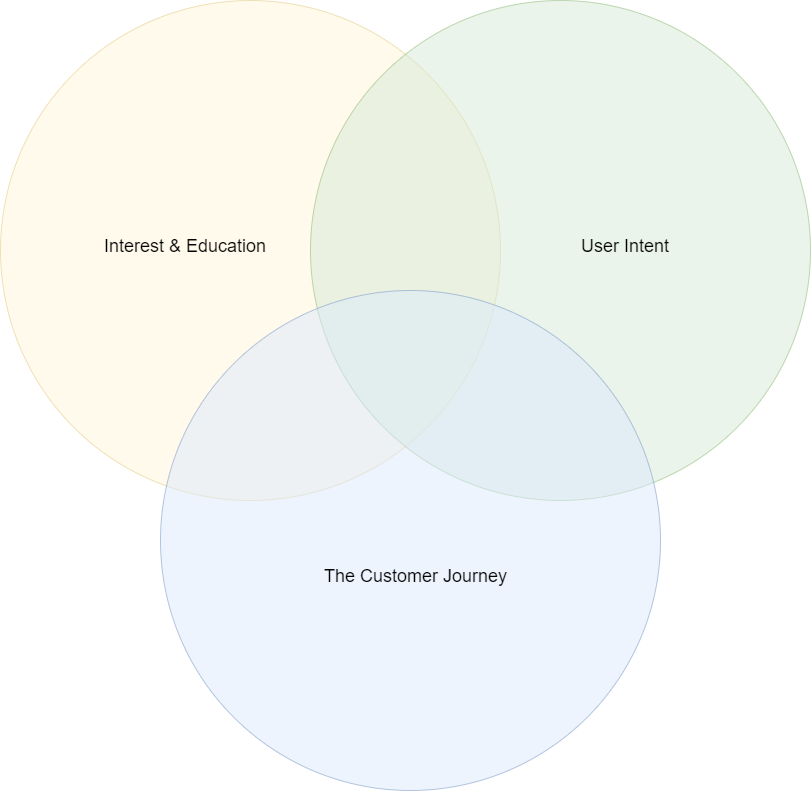The world is more connected than ever before, and your customers are looking for answers to their questions. This means that as digital marketers, it is our responsibility to consider the needs of our readers, understand their needs, and produce amazing content that addresses their needs.
Pretty easy, right? Just make some content that people will love and cash the checks!
Well, hold on a second… things are a bit more complicated than that. There are many variables you need to consider when choosing the type of content to use for your online marketing strategy.
The only way to make excellent content is to first consider things like the interest and education of your customers, user intent, and the journey your customers take to arrive at specific pieces of content.

This means there is no universal rule when it comes to the “best length” of website content because it depends on your audience, your product, and your business goals.
However, there is a proven process to decide on the best length of content to produce for your marketing strategy.
Let’s Define Long-Form and Short-Form Content
Just like there are different types of content (blogs, YouTube, podcasts, etc.) you can use to reach your audience, there is also a science behind choosing the best length of copy. Based on the goals and intent of your users, you can make a choice between short-form and long-form content to reach your readers.
Long-form content is typically 2,000 words or more. This type of material is usually seen as whitepapers, e-books, and how-to guides.
Short-form content is typically any written copy that is around 1,000 words. Things like social posts, blog posts, and emails are great examples of short-form content.
Does Copy Length Matter?
You might be thinking, “OK, great. So, is short-form content better than long-form content?”
The quick answer is yes.
And no.
You can find lots of research out there showing the importance of both long-form and short-form copy. In fact, a recent SEJ article revealed that short-form content can be better than long-form, depending on the goal.
Yet, another SEJ article showed that long-form content was better than short-form copy.
So, what gives? How can two articles on the same site say two different things?
Well, I think the thing that is missing is the purpose and user intent.
Long-form content and short-form content are just tools marketers can use. Neither tool is necessarily better than the other, but each should only be used in specific situations and for a particular reason. Whether you are looking to produce relevant content for an e-book or you want to write content for a page on your website, you need to consider the interests, purpose, education, and intent of your customers.
Here are some times when long-form copy is best for a marketing strategy:
- High-end products and services that are on the higher end of the price scale
- Goods and services that require more commitment to purchase
- Business-to-business sales often require longer copy because the purchasing cycle is complex and very long.
- Products that need to showcase quality and need information-based marketing
- Long-form content is often best in the early stages of marketing cycles, when your audience has little to no awareness of your products or services.
- Technical products need long-form content to explain complex aspects for a proper pitch.
At the same time, there are times when short-form content will have the most impact on your marketing efforts:
- When your readers are familiar with your business and trust your products and services
- Less expensive or commonly used products often benefit from description pages with short-form copy.
- If your customers have already qualified themselves as ready to purchase from you
- Some forms of content require short content (PPC ads, email subject lines, etc.).
The debate on the best length of copy is irrelevant from the user’s perspective since the length content depends on the context of how the information is used.
Now that we covered the necessary application for long-form and short-form content, let’s take a deeper look at five questions you should ask to help you decide which is best for you in a given situation.
5 Key Questions to Help You Find the Best Length for Your Copy
Since there is no rule for the best length of content to use in all situations, you can use some principles to determine the best length of content for your given situation. Before creating any copy, your entire team should review your customer personas and ask these five questions.
1. How Much Do Your Customers Know?
The first question to ask when choosing the length of your content is how much your customers know about you and what you are offering.
Long-form copy can significantly outperform shorter forms of content when your readers need more education about your products or services. This is because long-form content provides more space to share your information, and you will see this used a lot on product description pages and new product launches.
In cases where your customers don’t know much about your offering, it might be best to use long-form content because it is perceived as more valuable and trustworthy. However, if your readers are familiar with your brand and products then you should use short-form copy to increase your conversion rate.
If you use long-form copy for customers who trust and have intent to buy from you then you will be wasting their time and they could leave without purchasing.
No matter what length of copy you choose, you will need to optimize your copy to get readers into a buying mood by diffusing their objections, answering their questions, and reducing their stress.
2. How Interested Are Your Readers?
The second issue you should consider when choosing between long-form or short-form content is the level of interest your readers have in whatever you are offering.
Your audience comes to your content with a pre-existing interest in your offer. Readers with a higher level of interest are more likely to read lots of information and details about the product before buying.
However, if your readers are not interested in your offer then you will likely want to use short-form content to capture their attention and not smother a conversion under thousands of unnecessary words.
No one will read through lots of information about a topic they don’t want to learn about. You will just annoy them with lengthy information and that could hurt your brand’s reputation.
The length of content depends on the enthusiasm your audience brings to the table. This is precisely why you should consider the intent and interest of your audience before choosing what types and length of content to produce. You can look at metrics like Time On Page, set Events, and refer to the User Flow in Google Analytics to learn more about the interest of your audience.
3. What Resources Does Your Business Have for Content Production?
The third question you should ask yourself when deciding whether you should make long-form or short-form content is the available resources your business has for content production. It takes time and resources to make excellent content that is relevant to your customers.
It goes without saying that it will take more time and resources for your team to make long-form content compared to short-form content. This is why your business needs to prioritize the type of content you produce based on the needs of your customers.
The time it takes to research, create, edit, optimize, and publish can be much longer, and long-form content often requires more people to create compared to short-form content.
The bottom line is that your online content needs to be entertaining and valuable for your readers. Google continues to tweak their algorithm to deliver relevant content to their users. This means you should mimic their strategy and produce content, regardless of length, to meet the needs of your readers.
4. What Is Your User Intent? Use Keywords to Mimic Their Intent
Once you identify the length required for your content, you should work to develop a set of keywords to integrate into the final production. These keywords should match the intent of your customers because these keywords will signal search engines that your content is relevant and you will rank higher in search results.
Along with keywords, you can also bump the SEO value of your content by using sub-headers. This type of formatting is particularly useful with longer content because it breaks up long blocks of text and they entice the visitor to continue reading.
They also appeal to skimmers who fast-hunt through a copy before reading for details to first ascertain its relevance.
5. What Are Your Business Goals for the Content?
Finally, think about your business goals when deciding on the proper length of content. Even though I put this question last, it is crucial because your goals matter.
Since you will be spending time and resources to produce content, you should think about why you are making content in the first place and what you consider a goal of your business.
Since both long- and short-form copy have their positive and negative attributes, your business can benefit from considering how short-form copy could hurt your business goals. The more concise text could bring about some adverse outcomes:
- A diminished response rate because of lack of depth of persuasive info
- A barrage of advice or customer service requests since the copy did not answer the prospect’s questions
- An increased number of refund requests or cancellations since service or the merchandise was not what the customer anticipated based on the limited information he read
Making the Best Choice for Your Business
Now that we have discussed the differences between long-form and short-form content, be sure to choose the best length of content based on the needs of your customers. At the same time, consider the context of purchase, so you integrate various elements of a conversion into your decision.
With this knowledge, you will be able to drive more traffic and boost conversions by choosing the type and length of content that is best suited for your customers.
Image Credits
Featured Image: WDnetStudio/Pixabay
Screenshots by Chris Giarratana, March 2017





